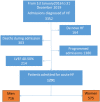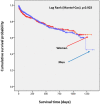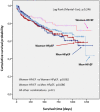The Female Sex Confers Different Prognosis in Heart Failure: Same Mortality but More Readmissions
- PMID: 33748194
- PMCID: PMC7973030
- DOI: 10.3389/fcvm.2021.618398
The Female Sex Confers Different Prognosis in Heart Failure: Same Mortality but More Readmissions
Abstract
Introduction: Heart failure (HF) is a major cause of morbimortality both in men and women. Differences between sex in etiopathogenesis, response to treatment, and quality of care have been found in patients with HF. Females are usually under-represented in clinical trials and there is no solid evidence demonstrating the influence of sex in the prognostic of chronic HF. The primary objective of this study was to analyse the differences in mortality and probability of hospital readmission between males and females with HF. The secondary objective was to compare mortality and probability of hospital readmission by ejection fraction (reduced vs. preserved). Methods: Patients with decompensated HF that were consecutively admitted to a Cardiology Service of a tertiary hospital for 4 years were recruited. De novo HF, death during hospitalization, programmed admissions and those patients with moderate left ventricular ejection fraction (LVEF) (40-50%) were discarded. Finally, 1,291 patients were included. Clinical profiles, clinical history, functional status, treatment at admission, first blood analysis performed, readmissions and mortality at follow-up were analyzed and compared. All patients underwent an echocardiographic study at admission. HF with reduced ejection fraction (HFrEF) was considered when left ventricular ejection fraction (LVEF) was <40%, whilst HF with preserved ejection fraction (HFpEF) was considered when LVEF was ≥50%. Results: 716 participants were male (55%). Basal characteristics showed differences in some outcomes. No differences were found in probability of survival among patients with decompensated HF by sex and ejection fraction (p = 0.25), whereas there was a clear tend to a major survival in females with HFrEF (p < 0.1). Females presented more readmissions when compared to males, independently from the LVEF (females = 33.5% vs. males = 26.8%; p = 0.009). Adjusted multivariate analysis showed no association between sex and mortality (HR = 0.97, IC 95% = 0.73-1.30, p = 0.86), although there was association between female sex and probability of readmission (OR = 1.37, IC 95% = 1.04-1.82, p = 0.02). Conclusions: Sex does not influence mid-term mortality in patients admitted for decompensated HF. Nevertheless, probability of readmission is higher in females independently from LVEF. Thus, it should be considered whether healthcare may be different depending on sex, and a more personalized and frequent care may be recommended in females.
Keywords: gender; heart failure; left ventricular ejection fraction; morbidity; mortality; readmissions; sex.
Copyright © 2021 López-Vilella, Marqués-Sulé, Laymito Quispe, Sánchez-Lázaro, Donoso Trenado, Martínez Dolz and Almenar Bonet.
Conflict of interest statement
The authors declare that the research was conducted in the absence of any commercial or financial relationships that could be construed as a potential conflict of interest.
Figures




Similar articles
-
Characteristics and Outcomes of Adult Outpatients With Heart Failure and Improved or Recovered Ejection Fraction.JAMA Cardiol. 2016 Aug 1;1(5):510-8. doi: 10.1001/jamacardio.2016.1325. JAMA Cardiol. 2016. PMID: 27434402
-
Clinical characteristics of hospitalized heart failure patients with preserved, mid-range, and reduced ejection fractions in Japan.ESC Heart Fail. 2019 Jun;6(3):475-486. doi: 10.1002/ehf2.12418. Epub 2019 Mar 3. ESC Heart Fail. 2019. PMID: 30829002 Free PMC article.
-
Clinical characteristics, one-year change in ejection fraction and long-term outcomes in patients with heart failure with mid-range ejection fraction: a multicentre prospective observational study in Catalonia (Spain).BMJ Open. 2017 Dec 21;7(12):e018719. doi: 10.1136/bmjopen-2017-018719. BMJ Open. 2017. PMID: 29273666 Free PMC article.
-
Heart Failure with Reduced Ejection Fraction (HFrEF) and Preserved Ejection Fraction (HFpEF): The Diagnostic Value of Circulating MicroRNAs.Cells. 2019 Dec 16;8(12):1651. doi: 10.3390/cells8121651. Cells. 2019. PMID: 31888288 Free PMC article. Review.
-
A Narrative Review on the Efficacy and Safety of Loop Diuretics in Patients With Heart Failure With Reduced Ejection Fraction and Preserved Ejection Fraction.Cureus. 2023 Sep 22;15(9):e45794. doi: 10.7759/cureus.45794. eCollection 2023 Sep. Cureus. 2023. PMID: 37872937 Free PMC article. Review.
Cited by
-
The stronger sex, until menopause: understanding the impact of estrogen loss on heart function.Am J Physiol Heart Circ Physiol. 2022 Jul 1;323(1):H128-H129. doi: 10.1152/ajpheart.00270.2022. Epub 2022 Jun 3. Am J Physiol Heart Circ Physiol. 2022. PMID: 35657615 Free PMC article. No abstract available.
-
Baseline mitochondrial DNA copy number and heart failure incidence and its role in overall and heart failure mortality in middle-aged women.Front Cardiovasc Med. 2022 Nov 10;9:1012403. doi: 10.3389/fcvm.2022.1012403. eCollection 2022. Front Cardiovasc Med. 2022. PMID: 36440036 Free PMC article.
-
Characteristics of women with type 2 diabetes and heart failure in Spain. The DIABET-IC study.Cardiol J. 2024;31(1):103-110. doi: 10.5603/CJ.a2023.0016. Epub 2023 Mar 10. Cardiol J. 2024. PMID: 36896635 Free PMC article.
-
Diastolic dysfunction and sex-specific progression to HFpEF: current gaps in knowledge and future directions.BMC Med. 2022 Dec 27;20(1):496. doi: 10.1186/s12916-022-02650-4. BMC Med. 2022. PMID: 36575484 Free PMC article. Review.
-
Sex Differences in Characteristics and Outcomes in Elderly Heart Failure Patients With Preserved Ejection Fraction: A Post-hoc Analysis From TOPCAT.Front Cardiovasc Med. 2021 Oct 4;8:721850. doi: 10.3389/fcvm.2021.721850. eCollection 2021. Front Cardiovasc Med. 2021. PMID: 34671652 Free PMC article.
References
-
- Ponikowski P, Voors AA, Anker SD, Bueno H, Cleland JGF, Coats AJS, et al. . 2016 ESC Guidelines for the diagnosis treatment of acute chronic heart failure: the task force for the diagnosis treatment of acute chronic heart failure of the European Society of Cardiology (ESC). Developed with the special contribution of the Heart Failure Association (HFA) of the ESC. Eur J Heart Fail. (2016) 18:891–975. 10.1002/ejhf.592 - DOI - PubMed
LinkOut - more resources
Full Text Sources
Other Literature Sources
Research Materials
Miscellaneous

